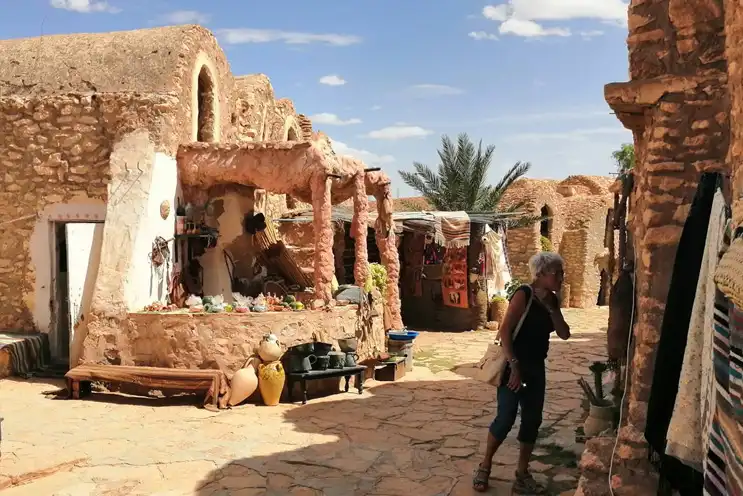Ksar Hadada is an enchanting and historically significant site nestled in the Tataouine region of Tunisia. It stands as an enchanting site of historical significance..
Ksar Hadada: Unveiling the Past
This ancient ksar, resembling a granary fortress, enthralls visitors with its timeless Berber architecture, embodying the region’s rich cultural heritage. Poised gracefully atop a desert hill, Ksar Hadada presents an enthralling panorama of the sprawling Sahara landscape. Its intricate construction, comprising interconnected earthen-brick structures, serves as a testament to the remarkable craftsmanship of local artisans. Adorned with elaborate geometric patterns, the walls recount the artistic legacy of the region. In antiquity, Ksar Hadada offered essential protection against desert raids, embodying its inhabitants’ resilience. Today, this historical gem magnetizes travelers and history enthusiasts alike, inviting them to bask in its unique allure and marvel at the enduring history embraced by its robust walls. Embarking on a journey through Ksar Hadada is akin to traversing time, immersing oneself in the indomitable spirit of the Berber people and connecting with the essence of Tunisia’s captivating history.
Unveiling the Heritage: Ksar Hadada’s Story
Situated a mere five kilometers from Ghomrassen and approximately eighty kilometers from Tataouine, Ksar Hadada, also known as Ksar Haddada, graces the southern reaches of Tunisia within the Tataouine region. This location reveals a captivating tale of heritage and time.
Climate and Rainfall: Ksar Hadada’s Environment
The climate in this region is semi-arid, with the Sahara Desert extending approximately twenty kilometers away. Rainfall is notably scarce; however, when it does occur, it descends with remarkable intensity. This climatic contrast shapes Ksar Hadada’s unique environment. During summertime, temperatures soar to a scorching 50°C, while winter nights witness temperatures plummeting to a chilling 0°C.
Protectors of Harvest: Ksar Hadada’s Ksour
Historically, the ksour (plural of ksar) held a strategic position atop mountains, serving as protective fortresses for valuable crops against potential looters. These ksour, featuring honeycombed alcoves, functioned as storehouses for vital resources like fodder, oil, and cereals. The vigilant presence of guards ensured the security of these granaries. Today, the majority of these structures have relinquished their functional roles; nonetheless, within their walls, a lasting testament to history perseveres, echoing through time.
Intrigue Amidst Ruins: Ksar Hadada’s Legacy
Although many of these ksour have faded into obscurity, the echoes of their past resilience and significance remain. Amidst the ruins, the essence of enduring history endures, underscoring the intrinsic connection between heritage and time.
Part of Ksar Hadada has been transformed into a hotel, catering to visiting tourists. Notably, director Georges Lucas utilized a portion of the ksar in the movie Star Wars Episode 1: The Phantom Menace, crafting the village of Mos Espa on the planet Tatooine, where Anakin Skywalker was born.
Accessible to all, Ksar Hadada is now a prominent stop on the tourist circuit. Travel agencies incorporate it into their Ksours packages, which include a visit to Tataouine, Ksar Haddada, and the Berber village of Chenini.

Comment (0)